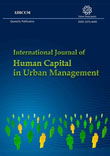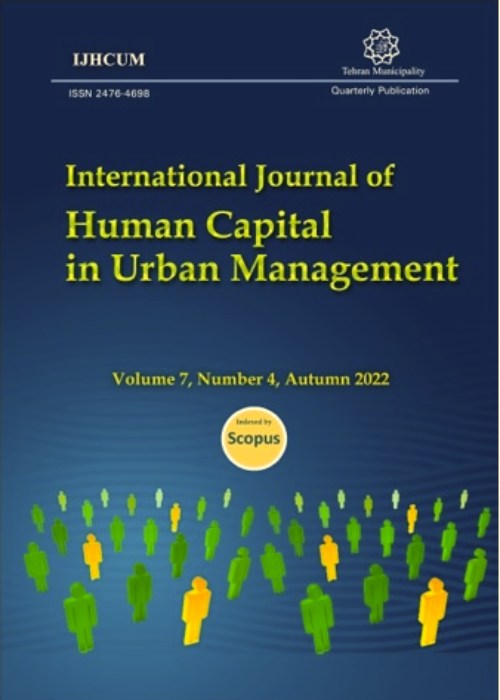فهرست مطالب

International Journal of Human Capital in Urban Management
Volume:1 Issue: 2, Spring 2016
- تاریخ انتشار: 1395/04/04
- تعداد عناوین: 8
-
Pages 73-82This paper explores the developing of how designers can search for inspiration source which provided in the form of traditional elements and archetypes and also their role on idea generation in design from building to urban measure. In order to clarify of this, current study focuses on the Far-East region as an ancient part of the world in which there is a huge number of symbols like well known, Yin-Yang. To understanding of how designers inspired by the symbols and forming the character of place via those, the case study method is used to an in-depth evaluation. The result is presented in a table involving cases which selected in divers rang of Far-East countries. Based on result, historical symbols, as a rich source of ideas and stimulation can play a significant in meaning-making and also forming the identity of city. In addition, these symbols help highly to revival the exiting values which ignored in contemporary urbanization particularly in developing countries like Iran. Accordingly, evaluation of cases observed that the symbol-inspired design can prove the durability of the urban character. Finally, inspiration source divided in two main types including: visual and verbal. Based on results of exist study, most of designers inspired visually (i.e. visual analogy, external) and a low percent of them inspired verbally (i.e. abstract, internal). Moreover, minority of designer inspired mediocre by combination of these (i.e. visual/verbal).Keywords: Idea, Inspiration, Symbol, Urban architecture, Yin, Yang
-
Pages 83-92The process of spatial distribution of urban services in order to provide equitable access to opportunities and reduced regional disparities, and earning the highest citizen satisfaction are among the main challenges facing urban management. This requires knowledge of the current status of spatial distribution of public services in the city, followed by optimal resource allocation under varying circumstances. This analytical-comparative study aimed to investigate the spatial distribution of urban public services, and rank different districts of Tehran in terms of benefiting from public services. To achieve this goal, quantitative models of planning, including factor analysis, composite Human Development Index, taxonomical model and standardization method were used. For the final ranking of districts of Tehran, the sum of numerical value of each district was calculated in four ways. Based on this method, districts 1, 3, 22, 12 and 6 were ranked first to fifth, and districts 13, 10, 8, 17 and 14 were ranked last, respectively. Using cluster analysis model, different districts of Tehran metropolis were clustered on the basis of numerical value of districts in the models used. Based on above-mentioned results, districts 1, 3, 12, 22, 6 and 21, with a final score of 66 and above, included in the first cluster and identified as over-developed districts; and districts 14, 10, 8 and 17, with a final score of 13 or less, included in the fifth cluster and identified as disadvantaged districts.Keywords: Human development index (HDI), Public services, Rankings, Spatial distribution, Tehran, Urban districts
-
Pages 93-102This study focused on the public transport risk assessment in District one of Tehran through Fault Tree Analysis involving the three criteria of human, vehicle and road in Haddon matrix. In fact, it examined the factors contributing to the occurrence of road accidents at several urban black spots within District 1. Relying on road safety checklists and survey of experts, this study made an effort to help urban managers to assess the risks in the public transport and prevent road accidents. Finally, the risk identification and assessment of public transport in District one yielded several results to answer the research questions. The hypotheses analysis suggested that safety issues involved in public transport are concerned by urban managers. The key reactive measures are investigation of accidents, identification of causes and correction of black spots. In addition to high costs, however, the reactive measures give rise to multiple operational problems such as traffic navigation and guaranteeing user safety in every operation. The case study highlighted the same fact. The macro-level management in the metropolis of Tehran is critical. The urban road casualties and losses can be curtailed by preventive measures such as continuous assessment of road safety.Keywords: Fault Tree Analysis (FTA), Public transport, Risk assessment, Safety management, Urban road accidents
-
Pages 103-116This research has been conducted with the aim of analyzing the spatial distribution of existing cultural land use in district 3 of Tehran Municipality and proposal for new site selection for cultural land use in this district. After studying previous researches on the issues of land use and site selection, 13 indicators for locating cultural land use were identified then by using distance mapping and according to their compatibility or incompatibility with cultural land use, land valuation was obtained. By overlaying data layers and applying their weight using Geographical Information Systems, the best places for new cultural land use were specified. The results showed that distribution of cultural land use in district 3 of Tehran is not desirable in terms of proper site selection and these places have been chosen randomly and without prior planning. So after investigating suitable sites for construction of cultural centers, optimal sites in accordance and matching with ground realities were identified, And finally proposal to create new cultural centers in the region were prioritized The research methodology was descriptive-analytical.Keywords: ANP Method_Arc GIS_Cultural land use_Region 3 of Tehran_Spatial Analysis
-
Pages 117-122The cancerous spread of slum has been a rampant problem in urban areas worldwide. The acute shortage of housing facilities compels the poor to live in slums. Proper rehabilitation is considered as a very essential remedial measure to provide better living environment to slum peoples. This study is an essential attempt to gauge the effectiveness of a rehabilitation program, which studies the changes in socio-economic and health condition of rehabilitated slum dwellers since they got rehabilitated. In order to do so, a household survey was carried comprising 240 households in two rehabilitated sites in the city of Kolkata (ward no. 107 and 114) during the month of July, 2014. The results conforms a strand of a belief that in-situ rehabilitation or rehabilitation within short distance is more effective. A rehabilitation too far away area disrupts the existing social, economic and political ties of neighborhoods. Measures have also been proposed to overcome such problems and to make the slum dwellers an integral part of urban society.Keywords: In, situ rehabilitation, Occupational shifting, Rehabilitation, Sanitation, Self, Help Group (SHG)
-
Pages 123-132The city is alive with dynamic systems, where parks and urban green spaces have high strategic importance which help to improve living conditions. Urban parks are used as visual landscape with so many benefits such as reducing stress, reducing air pollution and producing oxygen, creating opportunities for people to participate in physical activities, optimal environment for children and decreasing noise pollution. The importance of parks is such extent that are discussed as an indicator of urban development. Hereupon the design and maintenance of urban green spaces requires integrated management system based on international standards of health, safety and the environment. In this study, Nezami Ganjavi Park (District 6 of Tehran) with the approach to integrated management systems have been analyzed. In order to identify the status of the park in terms of the requirements of the management system based on previous studies and all Tehran Municipalitys considerations, a check list has been prepared and completed by park survey and interview with green space experts. The results showed that the utility of health indicators were 92.33 % (the highest) and environmental and safety indicators were 72 %, 84 % respectively. According to SWOT analysis in Nezami Ganjavi Park some of strength points are fire extinguishers, first aid box, annual testing of drinking water and important weakness is using unseparated trash bins also as an opportunities, there are some interesting factors for children and parents to spend free times. Finally, the most important threat is unsuitable park facilities for disabled.Keywords: Health, safety, environment (HSE), Park, SWOT analysis, Urban green space
-
Pages 133-140One of the major challenges in mega cities is the degree of the preparedness of organizations, institutions and people in facing with critical conditions and their immediate reaction according to pre-defined instructions.
Identification of priorities and acting accordingly is an undeniable factor in urban crisis management. The purpose of this research was to identify the priorities of preparedness and readiness to immediate responses in case of large fire incident occurrence in the urban areas. District 9 of Tehran municipality was selected as a case study. Considering the Specific regional conditions of this area such as high population, old unstable housing constructions, presence of Mehr-abad air port at the heart of the district, and the gas transmission pipeline mark this district as a vulnerable area to fire incidents. According to the crisis management readiness index, 2 types of questionnaires were distributed among members of the crisis department and fire rescue forces of the district 9. The results reviled that the most important priorities were basic training to residents, equipping the gas valves with automatic cut off switches in an emergency situation, training the responsible personnel to act efficiently in the early hours of accident and performing maneuvers. SPSS software was used for statistical analysis and Cranachs alpha coefficient was used to test the reliability of the questionnaire and to test the hypotheses single-sample T -test was used.Keywords: Effective factor, Fire incident, Immediate reaction, Preparation programs, Urban crisis -
Pages 141-148Urban management in any context has a different economic, social and political structure, which is in harmony with the existing models of organization. In spite of these differences, in order to reach a sustainable urban development, several different conferences should be referred to. In the Brundtland Commission 1987 about urban sustainable development these definitions have been given: preservation and promotion of the quality level of city life. This consists of ecology, culture, politics, economies, and social participation. However, this development should in no case weigh on and create any problems for the future generations. In all the definitions of urban management and urban sustainable development and in any political context citizens participation in decision making and insistence on social justice are mentioned. The aim of this article is a descriptive, analytic, and comparative study of different models of popular participation in different developed countries. Each of these countries has different social and political structure. However they all have the same aim which is the citizens empowerment. To reach the ideal urban management model it is necessary to have a clear image of the place and participation of citizens in order to create a socially, economically and politically sustainable developed society.Keywords: Participation, Participatory model, Public participation, Urban management, Urban sustainable development


